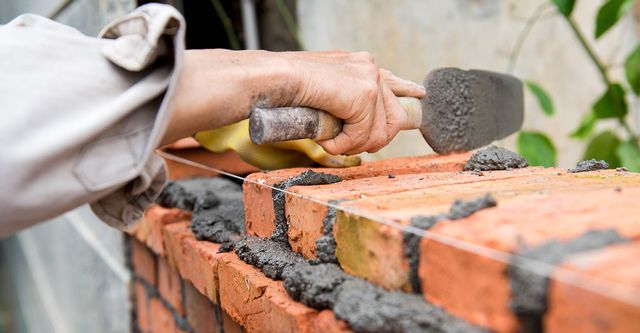Opening the Keys of Sustainable Stonework Building And Construction Practices for Eco-Friendly Buildings
Amongst the myriad methods to green building, sustainable masonry building stands out as a tried and true and long lasting technique that holds a riches of untapped potential. From the choice of products to cutting-edge construction strategies, the tricks to achieving sustainability within masonry building are diverse and appealing.
Benefits of Lasting Stonework Building And Construction
Accepting sustainable stonework building and construction practices not only lowers ecological effect yet additionally provides long-term financial advantages to contractors and communities. By using materials like recycled bricks, blocks, and stones, home builders can dramatically reduce the carbon impact of their jobs while advertising resource effectiveness. Furthermore, sustainable masonry building and construction techniques, such as appropriate insulation and thermal mass residential or commercial properties, can enhance power performance within buildings, leading to minimized functional expenses in time.
Furthermore, the durability and durability of masonry structures contribute to long-lasting financial advantages. Structures constructed making use of lasting masonry techniques commonly require less upkeep and repair, translating to set you back savings for building contractors and homeowner. The long life of masonry materials also guarantees that structures remain steady and safe and secure, decreasing the requirement for constant restorations or substitutes.
Eco-Friendly Masonry Materials
Making use of environmentally friendly stonework materials is an essential action in the direction of enhancing the sustainability of building practices and reducing environmental impact while maximizing lasting financial benefits. Lasting masonry products are sourced, generated, and used in a manner that lowers total ecological effect. Sustainable concrete blocks incorporate recycled aggregates and might feature better insulation homes, contributing to power performance in structures.
In addition, all-natural materials like adobe, rammed earth, and straw bales provide exceptional thermal mass properties, lowering the demand for home heating and cooling down energy. These materials are frequently locally available, advertising local economic climates and decreasing transportation-related carbon discharges. By choosing environmentally friendly stonework materials, building projects can considerably lower their environmental footprint and add to the development of much healthier, extra sustainable constructed settings.
Energy-Efficient Masonry Strategies
Energy effectiveness plays a vital function in enhancing the sustainability of masonry building practices. By executing energy-efficient masonry techniques, building contractors can significantly lower the overall energy usage of a structure, causing lower operational expenses and a smaller ecological impact. One essential energy-efficient masonry strategy is making use of thermal mass, which entails integrating dense materials like concrete or brick into the structure's framework to soak up and keep warm. This helps regulate interior temperature levels, reducing the demand for mechanical heating and cooling systems.

Technologies in Sustainable Stonework
Current visit this page developments in sustainable masonry methods have produced innovative methods that are reshaping the building sector. One such innovation is the advancement of self-healing concrete, which makes use of germs installed within the concrete to recover cracks autonomously. This innovation not just lowers maintenance costs yet also enhances the resilience of stonework structures, adding to their sustainability.
One more remarkable advancement is using recycled aggregates in stonework building and construction - masonry contractor. By including materials such as crushed ceramic waste or recycled glass into concrete mixes, contractors can decrease the environmental effect of building and construction projects while maintaining structural honesty. This practice not just draws away waste from land fills but likewise preserves natural deposits, making it an essential advancement in lasting masonry building and construction
Moreover, the combination of digital style tools, such as Structure Information Modeling (BIM), is reinventing the method stonework frameworks are prepared and constructed. BIM enables more accurate calculations, minimized material wastefulness, and boosted energy efficiency, eventually causing more lasting building techniques. These technologies collectively signify a promising future for lasting masonry building in the era of green structures.
Future Trends in Masonry Sustainability
With the cutting-edge strides made in lasting masonry techniques, the future patterns in stonework sustainability are poised to more reinvent the building industry. Among the vital trends shaping the future of masonry sustainability is the raised assimilation of innovation. Advancements such as Building Info Modeling (BIM) and virtual truth simulations are being utilized to maximize stonework construction procedures, leading to decreased material waste and enhanced power efficiency in buildings.
Additionally, the advancement of unique sustainable materials is established to play a considerable duty in enhancing the eco-friendliness of stonework building and construction. masonry contractor. Advancements like self-healing concrete, recycled accumulations, and bio-based binders are gaining traction for their capability to decrease ecological influence while preserving structural site integrity

Final Thought
Finally, lasting stonework building and websites construction practices offer numerous benefits for environmentally friendly structures. By using eco-friendly materials and energy-efficient methods, masonry can add to a more lasting developed setting. Technologies in sustainable stonework are continuously being created to better enhance the ecological efficiency of buildings. Looking in the direction of the future, the pattern of stonework sustainability is expected to expand, resulting in even more eco pleasant and energy-efficient building techniques in the years ahead.